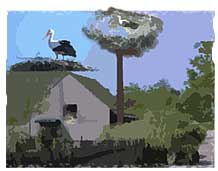|
Chava Rosenfarb was born in Lodz, Poland. She is a survivor
of the Lodz Ghetto as well as of the Auschwitz and Bergen-Belsen
concentration camps. She is the recipient of numerous literary
prizes. In 1979 she was awarded the Manger Prize — the
highest award for Yiddish Literature — for her trilogy,
The Tree of Life (Der Boim Fun Leib). She now
resides in Canada.
The
following excerpt comes from the first chapter of Rosenfarb's
novel Bociany, the first in a two-volume saga that follows
the destinies of characters from the Polish village of Bociany
as they grew up, grow old and leave the shtetl for the
city.
|
Far in the valley Hindele
saw Bociany wreathed by the two poplar roads, the Narrow and the Wide. It had
been by the nearer one, the Wide Poplar Road, that she had arrived in the shtetl
to marry Reb Hamele. She had always liked the shtetl's name. Storks built
their nests on its rooftops. The Polish word for storks is "bociany,"
so the name of the shtetl was Bociany.
As she gazed down upon it,
she saw Bociany nestled between the Blue Mountain and the White Mountain, itself
looking like a stork's nest. The pointed, dark-yellow straw roofs and brick-colored
shingle roofs peeked out like the bills of young fowl. It was a remote, forgotten
shtetl, where time seemed to arrive very slowly. News, when it reached
Bociany through the Wide Poplar Road that led from Chwosty, the closest town,
was so old that it had already grown a beard.

The valley in which Bociany lay was an offshoot of the larger Vistula Valley.
With the exception of a swampy ring surrounding the shtetl, the region
was blessed with good, rich soil. Hindele's eyes wandered over the fields of
rye and wheat, oats and potatoes interspersed by green pastures and orchards,
which stretched mile upon mile into the distance. Here and there, like islands
dotting the gold and green, were the stark shadows of forest land or the glimmering
mirror of a lake or a pond. . . .
Aside from the fact that
the noise of the world reached it even later than other Polish shtetlekh,
Bociany differed very little from Hindele's home shtetl or the shtetlekh
(pl.) she knew. That is to say, Bociany was something between a little town
and a village, and its official representative was not a burgomaster but a county
officer. As in the other shtetlekh, Bociany's life centered around the
cobblestone marketplace, where the peasants from the countryside gathered to
sell their wares on Tuesday market days. The marketplace was surrounded only
by a few brick or stone buildings. From where she now sat, Hindele could see
the buildings protruding from the density of wooden huts like a half-circle
of uneven teeth, the tallest and pointiest being the Church of All Saints.
And yet Hindele considered
Bociany an exceptional shtetl. This fact had struck her as soon as she
had approached it for the first time and its rooftops had come into sight. It
was amazing. Each one of the roofs, whether it covered a proud brick house or
a moldy sunken shack, whether it belonged to a Jewish or to a gentile family,
displayed an old wheel attached to its front like a box of phylacteries. On
these wheels pairs of storks would build their nests every year, lay their eggs,
and sit on them until they hatched, then bring up their young and stay on for
the rest of the summer.
|
 From:
Chava Rosenfarb, Bociany. Translated from the Yiddish by the
author. © 2000 by Chava Rosenfarb (Syracuse, New York: Syracuse University
Press), pp. 8-13. Excerpted by permission of the publisher. From:
Chava Rosenfarb, Bociany. Translated from the Yiddish by the
author. © 2000 by Chava Rosenfarb (Syracuse, New York: Syracuse University
Press), pp. 8-13. Excerpted by permission of the publisher. |
|